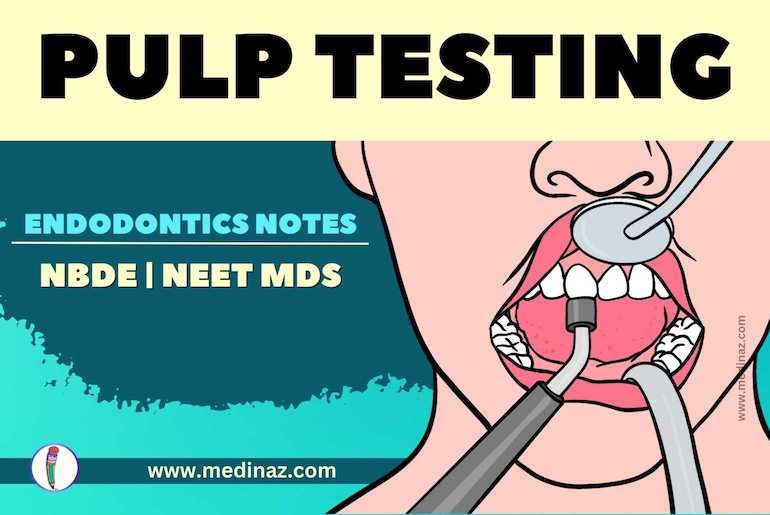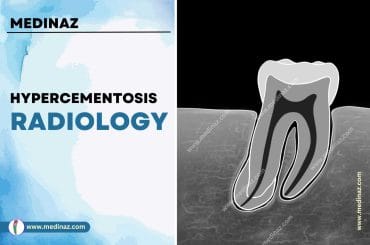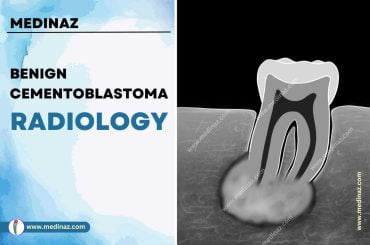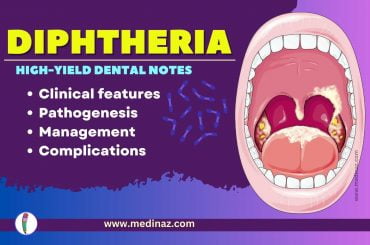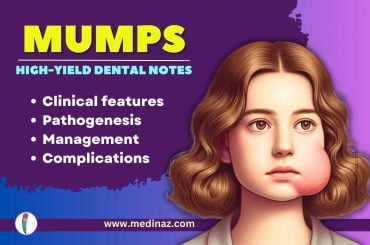- Pulp testing determines the responsiveness of pulpal sensory neurons.
- Tests involve thermal or electrical stimulation of a tooth to obtain a patient’s subjective response.
- Objective tests can also be used to assess the integrity of the pulpal vasculature.
- Histological examination is necessary for a quantitative evaluation of pulp tissue status.
- Objective clinical signs and symptoms do not always correlate well with pulpal histology.
Thermal pulp testing
Cold Testing:
- Normal response: Sensation felt but disappears upon removal of the cold stimulus.
- Abnormal responses: Lack of response, lingering or intensified pain after stimulus removal, or immediate, excruciating pain upon stimulus placement.
- Frozen carbon dioxide (dry ice) or refrigerant spray are reliable methods for cold testing.
- Frozen carbon dioxide is effective for evaluating pulpal response in teeth with full coverage crowns when other tests like electric pulp testing are not possible.
- CO2 stick is prepared by delivering CO2 gas into a plastic cylinder and applied to tooth surface.
- Refrigerant spray is applied to a large cotton pellet placed on the tooth.
Heat Testing:
- Useful when patient complains of intense dental pain upon contact with hot substances.
- When a patient is unable to identify which tooth is sensitive, a heat test is appropriate
- Isolate each tooth with a rubber dam and use an irrigating syringe to apply liquid of similar temperature.
- Immediate, intense painful response indicates the offending tooth.
- Delayed response may occur, so waiting 10 seconds between tests is recommended.
- Heated gutta-percha or compound stick can be used, with lubricant applied to prevent adherence.
- Electronic heat-testing instruments are also available.
Complementary Tests:
- Cold and heat testing should be used in conjunction with electric pulp testing for verification.
- Lack of response to both cold and electric pulp testing in a mature, nontraumatized tooth indicates pulp necrosis.
Multirooted teeth may respond to testing even if some roots have necrotic pulp tissue.
Clinical Application:
- Heat testing helps identify sensitive teeth when the specific tooth is unknown.
- Cold application can alleviate pain and aid in diagnosis for teeth sensitive to heat.
- Tooth responding to heat and relieved by cold is typically necrotic.
Electric Pulp Testing
- Electric pulp testing assesses pulp vitality by measuring the response to electric stimulation.
- Vitality is determined by the health of the vascular supply, not the status of nerve fibers.
- Electric pulp testers should be part of dental practice, but blood supply-based vitality determination is not yet perfected for routine use.
- Limitations of electric pulp testing: Response does not reflect histologic health, only indicates presence of viable nerve fibers.
- Numeric readings are significant if significantly different from control tooth readings.
- Lack of response to any electric current often indicates necrotic pulp.
- False-positive and false-negative responses can occur, influencing the diagnosis.
- Proper use requires tooth isolation, drying, and coating the probe tip with a medium like toothpaste.
- Testing involves placing the coated probe on the incisal third of the tooth’s facial or buccal area and completing the circuit with patient touch or lip clip.
- Electric pulp testing can be limited by the inability to complete the circuit when wearing rubber gloves for infection control.
- Some electric pulp testers require patients to place their finger(s) on the probe to complete the circuit, while lip clips can serve as an alternative.
- Isolating and drying the evaluated teeth is crucial for accurate electric pulp testing.
- A control tooth of similar type and location should be tested first to establish a baseline response.
- The suspected tooth should be tested at least twice to confirm results.
- Bridging technique can be used for teeth with complete coverage crowns or extensive restorations.
- Sensitivity and specificity vary among thermal and electric pulp testing methods.
- Cold tests are more reliable in younger patients with less developed root apices.
- Results should be verified and compared with other testing methods.
- Thermal and electric pulp testing will continue until vascular supply assessment methods improve.
1
False-Positive Responses
1. Partial pulp necrosis
2. Patient’s high anxiety
3. Ineffective tooth isolation
4. Contact with metal restorations
2
False-Negative Responses
1. Calcific obliterations in the root canals
2. Recently traumatized teeth
3. Immature apex
4. Drugs that increase patient’s threshold for pain
5. Poor contact of pulp tester to tooth
Laser Doppler Flowmetry
- Laser Doppler flowmetry (LDF) assesses blood flow in microvascular systems.
- Adaptation of LDF technology is being explored to assess pulpal blood flow.
- A diode projects an infrared light beam through the tooth crown and pulp chamber.
- The scattered infrared light beam’s frequency shift indicates the velocity of moving red blood cells using the Doppler principle.
- LDF has been found to be accurate, reliable, and reproducible in assessing pulpal blood flow.
- Objective data are collected, eliminating reliance on subjective patient responses.
- LDF is particularly useful in cases of luxation injuries where electric and thermal pulp testing may be inaccurate.
- Despite its effectiveness, routine use of LDF in dental practice is not common.
Pulse Oximetry
- Pulse oximeter is a noninvasive device used to measure oxygen concentration in the blood and pulse rate.
- It transmits red and infrared light through a translucent body part (e.g., finger, earlobe, tooth) and detects the absorbed light on the opposite side.
- Microprocessor calculates pulse rate and oxygen concentration based on the difference between emitted and received light. (ref)
- Obstruction from restorations can limit the effectiveness of pulse oximetry for pulp vitality testing.
- Custom-made sensors have been developed and found to be more accurate than electric and thermal pulp tests.
- Useful for evaluating teeth with traumatic injuries, especially in the short term.
- Studies on pulse oximetry for pulp vitality diagnosis yield mixed conclusions.
- Some studies support its reliability, while others suggest current technology limitations.
- Cumbersome and complicated devices for pulp testing hinder routine use in dental practice.
Bite Test
- Percussion and bite tests are performed when a patient experiences pain while biting.
- These tests help to determine the specific tooth causing the pain when the patient is unsure.
- Sensitivity during biting can be due to pulpal pathosis extending into the periodontal ligament space (symptomatic apical periodontitis) or a crack in the tooth.
- Periradicular periodontitis will elicit pain during percussion and bite tests, regardless of the applied pressure on the coronal part of the tooth.
- A cracked tooth or fractured cusp will typically cause pain when pressure is applied in a certain direction to a specific cusp or section of the tooth.
- Devices such as cotton tip applicators, toothpicks, orangewood sticks, rubber polishing wheels, Tooth Slooth, and FracFinder can be used for the bite test.
- Adjacent and contralateral teeth should serve as controls to determine the normal response to the tests.
- During the bite test, a device is placed on the cusp to be tested, and the patient applies biting pressure to the opposite side of the device’s flat surface.
- Biting pressure should be applied slowly until full closure, maintained for a few seconds, and then released quickly.
- Each cusp can be tested individually.
- The clinician should observe whether pain is elicited during the pressure phase or upon quick release of the pressure.
- Pain upon release of biting pressure is commonly associated with a fractured cusp or cracked tooth.
Test Cavity
- The test cavity method is an invasive and irreversible test used as a last resort when other tests are not possible or inconclusive.
- It is typically employed when a tooth with a full coverage crown is suspected of having pulpal disease.
- If electric pulp tester and cold test results are inconclusive and bridging techniques are not applicable, a small class I cavity is prepared through the occlusal surface of the crown.
- The procedure is performed without anesthesia, and the patient is asked to report any painful sensations during drilling.
- If pain is felt upon reaching sound dentin, the procedure is stopped, and the class I cavity is restored. This indicates the presence of viable nerve tissue in the pulp but does not confirm complete pulp health.
- If the patient does not feel any sensation when the bur reaches the dentin, it suggests pulp necrosis, indicating the need for root canal therapy.
Staining and Transillumination
Staining:
- Staining is useful for detecting surface cracks in teeth.
- Methylene blue dye is commonly used, applied with a cotton tip applicator.
- The dye penetrates into cracked areas, indicating the possible location of the crack.
- Excess dye can be removed with 70% isopropyl alcohol.
Transillumination:
- Transillumination involves using a bright fiberoptic light probe on the tooth’s surface.
- Directing the light at the cementum-enamel junction (CEJ) can reveal the extent of the fracture.
- Fractured teeth block transilluminated light, causing the affected area to appear gray compared to the glowing area proximal to the light source.
- While dyes and transillumination can detect the presence of a fracture, they may not provide information about the depth of the fracture.
Selective Anesthesia
- Selective anesthesia is useful when symptoms are not localized or referred, making diagnosis challenging.
- If the patient cannot specify the arch causing the pain, the maxillary arch is selectively anesthetized first.
- Periodontal ligament (intraligamentary) injection is administered starting from the distal sulcus of the most posterior tooth in the suspected quadrant.
- Anesthesia is then administered anteriorly, one tooth at a time, until the pain is eliminated.
- If the pain persists, the same technique is repeated on the mandibular teeth.
- Periodontal ligament injections may also anesthetize adjacent teeth, making them more helpful in identifying the arch rather than a specific tooth.
Check Medinaz Visual Dental Books
Why choose Medinaz Visual Dental Books for your NBDE, NEET MDS, and Board exam preparation?
1. Comprehensive Visual Content: Simplify complex dental concepts with visually engaging content that facilitates better understanding.
2. Exam-Focused Approach: Strategically organized to cover key topics and high-yield areas, Medinaz helps you focus your studies efficiently and effectively.
3. Interactive Learning: Visuals, illustrations, mnemonics, and diagrams enhance retention and make grasping dental concepts easier.
4. Easy-to-Follow Format: User-friendly chapters present information in a step-by-step manner, allowing you to review at your own pace.
5. Practice Questions and Explanations: Assess your progress, identify areas for improvement, and sharpen problem-solving skills with practice questions and detailed explanations.
Reference:
- Cohen’s Pathways of the Pulp; 11th Edition; by Louis H. Berman DDS FACD (Author), Kenneth M. Hargreaves
- Grossman’s Endodontic Practice; 14th Edition
You may also like these Free Notes
A Visual Learning Platform

